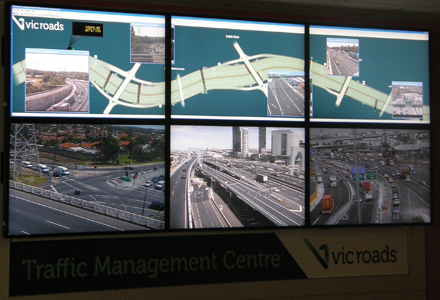
Following a successful trial in 2007, VicRoads has adopted Streams Motorway Management from Transmax as its primary traffic management and control system
Throughout the world, the avoidable social cost of traffic congestion continues to rise each year with increased motorisation, urbanisation and population growth. Traffic congestion is responsible for an increase in travel times, vehicle operating costs and carbon emissions.In 2007,
Streams has demonstrated reductions in the avoidable social cost of traffic congestion on the M1 motorway in Melbourne through this project. These savings include a 30% reduction of accidents on the motorway. (International toll road developer and manager
STREAMS MOTORWAY MANAGEMENT DEPLOYMENT BY VICROADS IN MELBOURNE, AUSTRALIA
Benefits:
• Economic benefits estimated at more than $1M per day.
• Accidents reduced by 30% on the motorway.
• Travel time reduced by 42% during peak periods on the motorway and 48 per cent in the tunnel.
• Greenhouse gas emissions reduced by 11%.
The system helped reduce travel time by 42% during peak periods on the motorway, and by 48% in the tunnel. Economic beneflts have been estimated at more than $1M per day while greenhouse gas emissions reduced by 11%. These saving have been achieved with a >25% increase in the sustainable peak hour ows on the motorway.
Significant improvements
Chief executive of VicRoads Gary Liddle says the upgrade of the M1 has led to several signiflcant improvements, of which Streams played a key role.“Following the upgrade of the M1 freeway and installation of Streams, travel times have been reduced and are now more reliable, which has in turn increased the freeway’s capacity,” Liddle says. “The system has enabled greater safety on the freeway, as well as making it more accessible for all users.”
After flrst introducing Streams to assist with the management of the M1, VicRoads has since adopted the
The Streams M1 system has won a number of national and international awards and this is generating interest in the system around the world. Principal engineer from ARRB Group John Gaffney says Streams Motorway Management has the ability to maximise the capacity of existing road infrastructure.
“Streams provides a fully integrated managed motorway and operations platform that integrates all the critical managed motorway technologies required to sustain near capacity peak periods flows and reduce travel times whilst improving day to day reliability and safety outcomes,” Gaffney says.
“The platform supports all the necessary day to day operational activities required to be undertaken by traffic management centres (TMC) including incident management, provision of up to the minute information for media channels and motorists, and provides well-developed analysis tools to enable historical evaluation of motorway performance.”
How Streams works
In addition to achieving award-winning results, another unique feature of Streams is its rules-based incident response functionality. Traditional incident response systems typically need more than 20,000 pre-deflned response plans. Many more plans are needed if secondary incidents are addressed. These plans are developed manually and are very expensive to produce. Policy changes such as a speed limit change often necessitate changes to thousands of plans. As a result, these plans are also expensive to maintain.In practice, the pre-deflned plans often don’t match the speciflc incident circumstances so typical TMC responses include a mix of pre-deflned plans and manually implemented controls. The result is that authorities typically specify that responses should be achieved in less than 15 minutes.
Streams incident response does not use pre-deflned incident response plans. All response plans are generated automatically using approximately 20 basic traffic engineering rules and the system’s embedded geographic information system (GIS). Major incident responses, such as the closure of a motorway, can be implemented in less than 10 seconds. Policy changes are also able to be implemented within seconds through a simple change to the relevant rule.
Fast and consistent
TMC operators simply identify the location and nature of the incident to initiate a response. The system then generates and implements the appropriate response plan automatically. If a secondary incident occurs, the additional incident details are provided and the system automatically adjusts the response to cater for the new circumstances. Fast and consistent responses are achieved with a major reduction in TMC workload.In addition, the Streams user interface is simple, elegant and comprehensive. It consists of interactive street directory style maps, schematics and fully customisable spread sheets for detailed data. The single user interface simplifles staff training and reduces operator errors.
Traffic management systems generate large quantities of data and this can sometimes mask important management information. Business Intelligence (BI) has been added to address this requirement. Streams BI transforms these large quantities of data into management information, so managers can quickly and easily slice and dice information and perform ‘what if’ scenarios.
A service oriented architecture enables Streams to be continuously and easily upgradable. New services replace old with minimal impact, algorithms within the major services are replaceable and multiple algorithms can be included and switched at run time if required. The system is fully scalable from small towns to large cities.
The Australian-owned company Transmax has been involved in traffic management systems since the late 1960s. The company deployed its first traffic signal management system in 1969, followed by a motorway management system in 1972. Today, the Transmax flagship product is Streams, a system designed to include all ITS functionality within a single product. It now manages traffic in Queensland, South Australia, Victoria and Tasmania.
Streams integrates all road traffic functionality within one system: motorway management, incident management, traffic signal management and network video management, traveller information including parking guidance and real-time passenger information. This ensures efflcient and effective interaction between these traditionally separate functions. The system interoperates with related systems such as public transport timetables, emergency services, police, and information service providers.











